Hello again fellow Steemitarians,
Its that time again, time to check out the latest blog from your sound man, Shan. In the last blog we looked at the 3 different types of microphones you are likely to come across when recording your music, either in a studio or your home studio (previous blog:https://steemit.com/music/@audio-nrg/first-steps-to-recording-your-music-pt-2-mics-and-mic-set-up). In this blog I'm going to go over the more typical mics that are used for vocal and instrument recording. Many of these you can find at a good online store or even ebay. In the next blog(pt4) I'm going to go over a few mic set ups you can use when you get ready to record your first big hit! (i want to add a video to it).
Please UP-VOTE this post and any other in my "first steps" series if you believe they are helpful to you and others in our steemit community. You can also promote this series as well by clicking the promote button at the end of the blog. If you want to know more about me or recording skills and more, you can subscribe to my AudioNRG YouTube channel.
OK, So lets look at some vocal mics for a getting a good sound. - from low Budget to Big time. Depending on your budget its always good to spend a bit of cash on great equipment if you're serious about your music. You don't need to spend $1000's and this article can really help you. If you really don't have any cash at all and are working on a shoe string budget then look at a cheap dynamic mic for 40$ or so, but make sure it can plug into a XLR cable because this will help a lot in getting a better sound quality than a generic TS cable.
This is an XLR cable, they are a balanced and properly insulated cable which helps eliminate Buzzing.
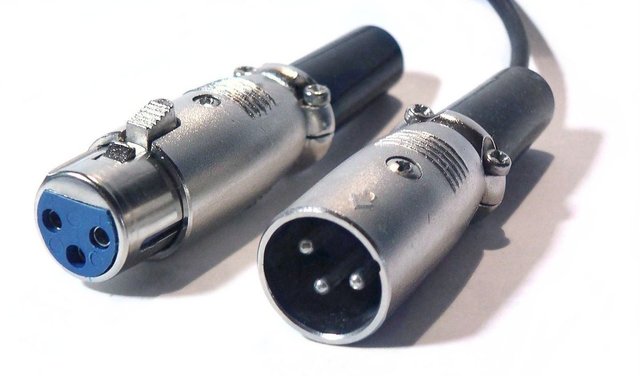
This is a TS Cable, they are not balanced and are often prone to electrical interference and can often get buzzing in your signal chain.

TS cables are used for most instruments like electric guitars and basses etc. but if you see one coming out of a microphone avoid it!. The signal from your mic to your sound card pre-amp (audio interface) should be clean and clear, you want the best noise free signal you can get and the XLR helps to give you that. These cables have a +, - and Ground pin and have shielding inside the cable as they were wound which reduces electrical interference. So, having good cables is very important before you start.
Next you want to think about your mic. Now as i said above, if you have a small budget then look on ebay for a cheap dynamic mic that takes an XLR cable input and you're already giving yourself an advantage. In our old band, i spent $40 on a mic, gave it to the singer and we used it as our main rehearsal mic for 3 years with no problem, it was a Peavey like this one:
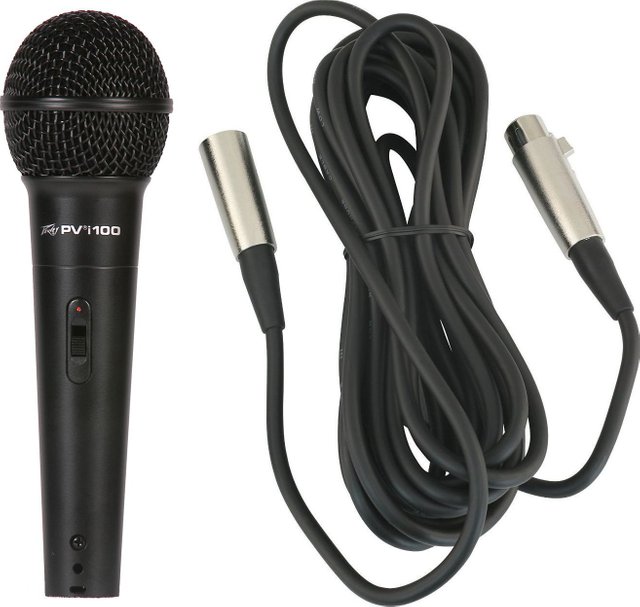
But lets upscale now.. there are plenty of good brands around for mics and the more notable ones are, Sennheiser, AKG, Audix, Shure, Neumann, Scheops, Rode, SE electronics, Electrovoice and Audio Technica. Nearly all these brands have a good vocal mic under $700 USD. Now, Some of the mics listed may not be right for all occasions, but they are good mics. Some of the good ones for vocals are:
the Shure SM58 and the Shure SM7B (used by Michael Jackson on the thriller album)

The EV Re20 (Below) is used nearly everywhere in broadcasting lately. This is due to its good frequency response in the lower ranges and because they have a large diaphragm. This combination allows a very receptive and sensitive mic to capture some good intonation in your voice at many ranges.

The Sennheiser MD421 is also good especially for rock vocals and low end toms in drums, the kick drum and bass guitars due to its frequency response being open and sensitive to lower end frequencies.

So these are all dynamic mics so far and provide a good response for vocal recording especial rock and even folk music. But lets now go to a few Condenser mics and see what you could consider. The First one would probably be the AKG 214, its affordable at around $600 and comes with a hard case to protect it. It doesn't have any multi pattern options but is cardioid and does what its meant to do.
It is a very clean mic and i used it often when i was recording at college for many sessions. It was actually hard to get hold of half the time. You can also get a paired kit in this model and a paired kit in the 414. There is no difference in the internal components between these models that i am aware of, only in options. The AKG 414 paired kit will cost you around $2000 USD but is very worthy! There are other options in these models which refer to updated changes over the generations.
214 with case

414 paired Kit

Nice huh! As you can see there are more increases in price as we move up the scale but you want to make sure you get something good and worthy of the work you need it to do. You can also use most of these (if not all) for your guitar or other instrument. The Sennheiser 441 (pic below) is a great pic for brass players as this mic has a flat frequency design that suits getting a good sound from brass sections in orchestras. They are placed a meter or two away from the from horns and are usually suspended above the brass section at about 3meters in height. They are pretty much good all rounders, with a very flat FR (frequency range) around 100Hz - 2kHz depending on where you roll off your low end.

It may be a good time to introduce you to a term i have used regularly here called Frequency Response (FR). This is the range that a microphone has and is tested on during their design phase. The goal is to try to get the mic to stay as flat as possible. The reason for this is to allow the mic to record all the acoustic features of the instrument or voice and also any acoustic room qualities that the recordist may want to get as well. By keeping the frequency response as flat as possible in the mic the engineer can find the sweeter qualities in the recording using EQ techniques to enhance, reduce or remove the areas in the frequency spectrum of the recorded instrument with better efficiency, such as removing annoying high end harmonics or lower end or mid resonances, as well as the elements of the voice or instrument that may naturally occur. Below is a graphic image of a frequency response table gathered from the testing of the Sennheiser 441 mic:

Finally there are some affordable ribbon mics on the market you can consider, such as the Rode Ribbon mic for around $680 AUD. Rode is an Australian company and quickly gaining a reputation for making very good products at great prices. I personally have a pair of Rode M5 condenser mics as a set, and Im looking into this particular ribbon mic as well. Remember that with ribbon mics you don't normally use 48v phantom power on the pre-amp and do not use them for instruments, they are very sensitive and prone to damage. Just keep them for your voice in a well controlled environment, or at a distance on an acoustic guitar.
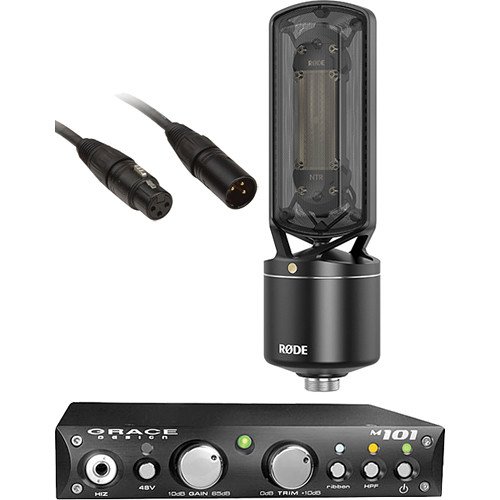
Another good Ribbon mic i would certainly suggest because i personally used one was a Samson VR88. This is one of the best mics i have ever heard for vocals and matched well against some very expensive peers. The natural tonal qualities of this mic are warm and a little dark and there is a natural roll off at 10kHz which reduces a lot of high frequency sibilance and top noise. This Mic is a little strange on price as it can be found as cheap as $380-400 and go up to $800-900 buckeroos! but at either end of the price scale this one is worth it! It also comes with a hard case and cradle.
Samson VR88 (one of the best i've mics ever heard under 200)

Ok, we have discussed mics as good for vocals and occasionally i have mentioned what might be good for particular instruments, but lets go into some more detail on this issue now.
Instrument: Acoustic guitar
Mic types: Condenser mics, (almost any kind works well, large or small diaphragms, and most polar patterns are useful as well but try the cardioid patters or a figure 8 where the poles run parallel to the neck.
Ribbon mics on nylon strings are great.
Electric guitar Amps
same as above but stick to the cardioid pattern and keep the mic close to the speaker. One of the most popular for recording Electric guitar is the Shure SM57

Bass (electric and acoustic)
Sennheiser MD421 (dynamic) for electric bass, most condenser mics for acoustic bass, or you can also use bass specific mics like the AudixD6, AKG D112 or the Shure Beta 56.


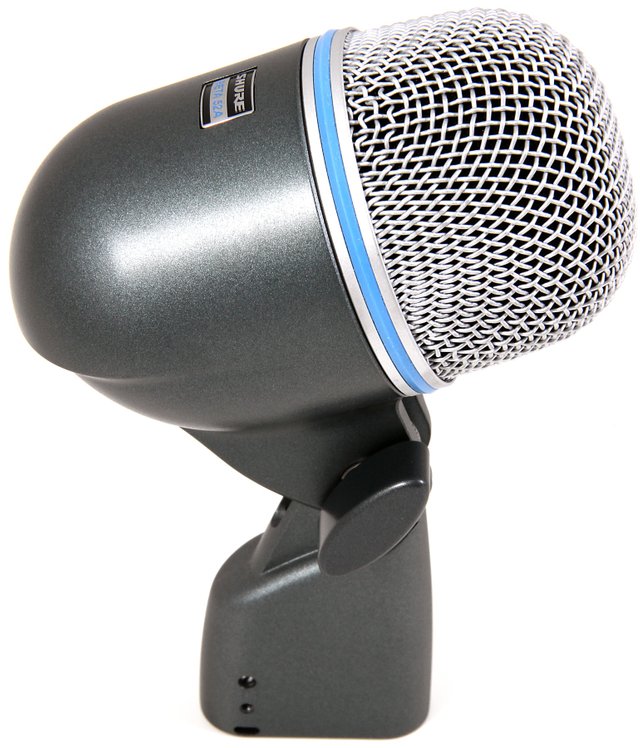
Drums:
There are many specific set ups for recording drums which i can share in another blog. Other good options are AKG 414's or Rode M5's or any small diaphragms are fine for overheads Shure sm57 for the snare, Sennheiser MD421 for floor tom or kick but if you want an affordable choice, Shure, Audix and AKG all have designated drum mic kits to use and look like this,
the Shure drum kit set. just google the names i listed here then ad drum mic kit. Prices start around $600 bucks.
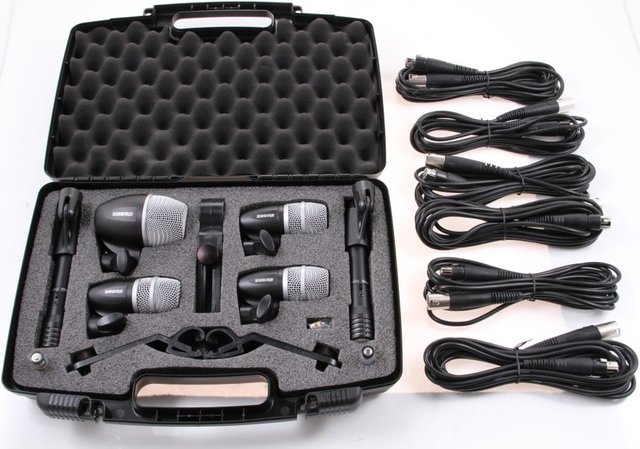
Grand Piano: The best ribbon or condenser mics you can find! plain and simple.
Brass: As mentioned above the Sennheiser 441 is well suited to brass instruments and often used in orchestras and other ensemble bands.
Harmonica: it may be a better choice to use a dynamic mic for this instrument as the dynamic mic is suited by design for the breathing movements of the instrument.
For Blue Grass bands, think about condenser mics for things like washboards, jugs, and banjos (or a sm57 for banjo would be good too) and the 441 for any wind instruments.
String ensembles: Condenser mics and set them equally apart but at a bit more of a distance to capture all the instruments collectively. You can 'close mic' some of the instruments such as the cello or double bass, but be ready to fix any phase issues you may encounter when they are all combined in the recording.
Well that's about it for now. There are some other tools and things to do with mics but we will look at them later.
If you found this useful, again please support me and others by UP-VOTING THIS BLOG or you can PROMOTE it and let others take advantage of this information, remember i studied this for years and paid alot and i want to share it with everyone freely. You can also check out my Youtube channel, FB, Twitter and website, AudioNRG.com , feel free to follow me here too! Thanks again and see ya next time where i will hopefully have a video blog to share and discuss mic positioning for recording your instrument! cheers.
regards
Shan The sound man
Do you plan on discussing software in the future? I'm curious about your DAW preference and what tools you use in your recordings.
Thanks for the informative post!
Downvoting a post can decrease pending rewards and make it less visible. Common reasons:
Submit
Hi there,
Yea i certainly will be discussing Software and DAWs more in the future. As a quick rundown, i mainly use protools, because im really confortable with that interface. I have come to know it pretty well and while at times it drives me completely nuts, i find it generally enjoyable to use, i think because i worked with it at college on larger set ups etc. My plugins mainly used for engineering are Slate Digital plugins, they work really well, look nice and give a really nice quality to a mix. I also use a few waves plugins and a few protools ones. A few others are Blue cat for the spectrum analyser (these are free) and for instruments i use 8DIO, and Spitfire audio for big orchestral stuff and Native instruments particularly a few in Reaktor and heavyocity, they're awesome. I hope this helps. If you want to see more of how i use these you can check out my youtube channel, audionrg, i got a fair few vids there you might like!
cheers mate.
Downvoting a post can decrease pending rewards and make it less visible. Common reasons:
Submit
Lots of useful information here. I hope that these posts get the attention they deserve.
Downvoting a post can decrease pending rewards and make it less visible. Common reasons:
Submit
Hi thank you for your kind words and feedback, i got plenty to share in the future!
cheers
Downvoting a post can decrease pending rewards and make it less visible. Common reasons:
Submit
Very nice.
Downvoting a post can decrease pending rewards and make it less visible. Common reasons:
Submit
Hi thanks for your feedback i really appreciate it, i will keep bringing it for ya.
cheers mate.
Downvoting a post can decrease pending rewards and make it less visible. Common reasons:
Submit
please do! I don't know enough about sound, but I believe that it is the future of making quality video content. Everyone has been focused on the 4k and 1080k resolution, but they neglect the sound. I believe that its 50/50 when it comes to quality. I had to put fur around my GoPro and stuffed some insulation in the shell to get the sound right for my flying videos. I like to vlog when i am in the air. You couldn't hear a thing before. But now it is much better. I will keep working on the sound.
Downvoting a post can decrease pending rewards and make it less visible. Common reasons:
Submit
Great and useful article , thank you for sharing your knowledge with us .

Downvoting a post can decrease pending rewards and make it less visible. Common reasons:
Submit
Hi no problem i love discussing this stuff! it makes me feel happy.
cheers
Downvoting a post can decrease pending rewards and make it less visible. Common reasons:
Submit
Hey shan , why there is no Audio Technica in here , what do you think about AT ? I think those mics are good. and also I see Neuman mics like Golds which I want to catch them one they ,LOL
Downvoting a post can decrease pending rewards and make it less visible. Common reasons:
Submit